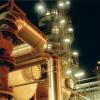Hello,
I am having a problem with this question regarding residence time distributions and was wondering if anyone could help.
I have been given experimental data for two reactors in series and been asked to calculate the combined residence time. The full question is in the excel sheet and the answer is given but I have not been able to calculate it on my own.
I have managed to work out the residence time and residence time distributions of the reactors separately but not together. This is where I'm stuck and need help.
If anyone could give tips or advice it would be greatly appreciated.
Thank you

 FB
FB











